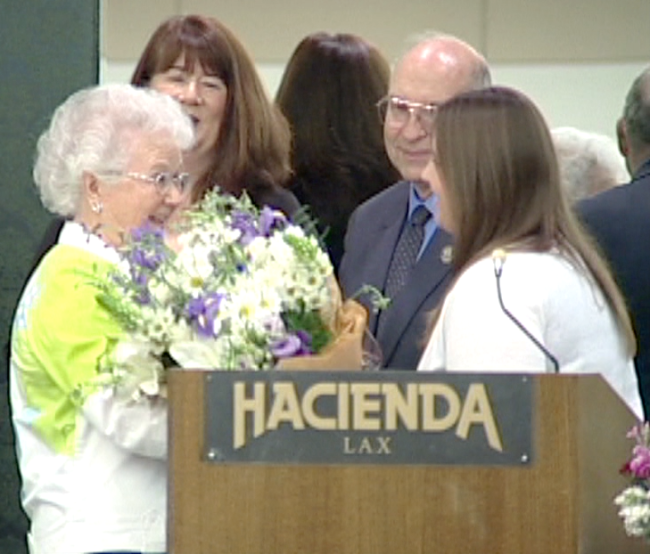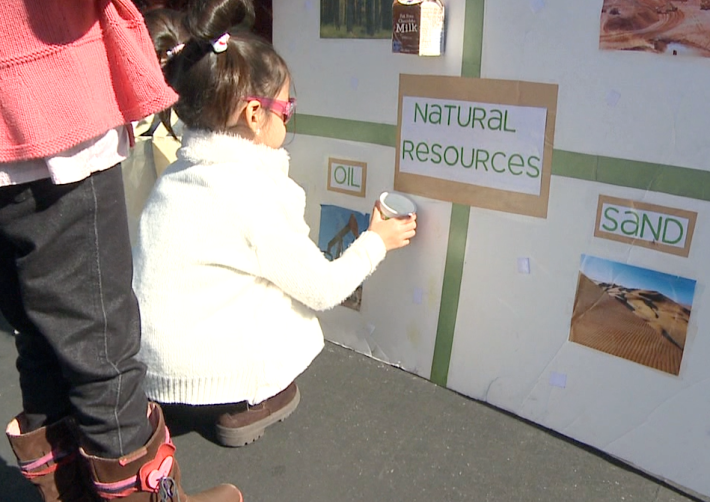Peter Parks/AFP/Getty Images
Visitors look at a display celebrating Chinese lunar new year in Shanghai on February 8, 2013. Preparations continue in China for the Lunar New Year which will celebrate the Year of the Snake on February 10.
This year, Lunar New Year is on Feb. 10. But those who celebrate the yearly tradition start much earlier than that. The cultural holiday involves many traditions, some which date back to ancient times, and though there are many variations on each, there are many that are widely celebrated.
1. Year of the Snake
There are twelve animals of the Zodiac. This year will be the Year of the Snake. Professor and Chair of the Department of Religious Studies at UC Riverside, Vivian-Lee Nyitray says that there are many variations on the snake’s characteristics, but overall people agree that a person of the snake year is charming, rational, intuitive and lucky with finances. She says the year is likely to be unpredictable and unstable, requiring people to prepare for the unexpected.
UC Irvine History Professor Yong Chen says the snake resembles the dragon, which is a symbol of power, dignity and prosperity. According to Chinese legend, ancient ancestors had a human face, but a body in the shape of a snake, so the snake represents ancestral worship. Chen says that some believe that the snake symbolizes longevity not only because of its shape, but also that it can regenerate life itself.
2. New Year’s Eve Dinner and Food
The New Year’s Eve Dinner takes place the night before the New Year, just like Christmas Eve the night before Christmas. Chen says it’s also like a Thanksgiving dinner, a time when the family gets together to celebrate. Along with the dinner comes a multitude of traditional foods.
Although there are regional variations, certain dishes in the meal often have symbolic meaning, Nyitray says.
The main dessert is the New Year’s Cake, made out of ground sticky rice. In Chinese, it is called “Nian Gao.” The “Nian” means “year,” while the “Gao” means “cake” and also “high” or “tall.” The overall meaning: A wish that the coming year will fulfill one’s high hopes. The cake may have fruits and nuts or seeds in it.
Fish is a common dish for the dinner. The word fish in Chinese is “yu,” which is a homophone for the word “plenty.” This symbolizes prosperity and surplus.
Oranges or tangerines are popular fruits for the new year. Since these fruits include segmented parts that make a whole, they symbolize a whole family made of individuals.
Nuts or seeds symbolize the hope for many children in the family. Some typical seeds used in the New Years dinner are sunflower, melon and pumpkin seeds.
Dumplings are also a common dish; its shape represents unity.
3. Cleaning
Prior to the New Year, the house needs to be thoroughly cleaned. The significance is in sweeping away any negativity from the past year. It also signifies a fresh start, a new beginning. This is the origin, in Chinese cultural areas, of “spring cleaning,” since New Year’s is also known as the “Spring Festival,” Nyitray says.
4. Decorations
The characters for auspicious words such as “spring,” “happiness,” “longevity,” “prosperity,” are written on squares of red paper to be pasted on one’s door.

One of the main characters in Chinese is called “fu,” which means good fortune. Sometimes the character is pasted upside down to indicate spirits looking down from above that the family’s fortunes have not been good and could use a change. In some interpretations, they’re inverted because the word for “upside down” is a homophone for “arrive,” and thus is a hope for the arrival of fortune. For some, the “fu” is pasted upside down so that devils would not know the meaning of it, therefore warding off evil spirits.
Couplets, a pair of often rhyming good wishes, are written on red paper to paste on either side of the front door.
New images of “door gods,” who are deified warriors that once guarded an emperor’s private chambers, are pasted on doors to guard the entrance to people’s homes.
Paper decorations could also include other auspicious images. Bats are one of them; the word for “bat” is a homophone for “fortune.” Ships carry the meaning of “smooth sailing” or “good fortune arriving easily.” Peaches are associated with Daoist notions of immortality and thus “long life.”
5. New Year’s Day
Visiting family is a major tradition on New Year’s Day. Some families stay awake for the whole night, while some retire after the midnight firecrackers. If they stayed up all night, they would wake up later to visit family and spend the day together. New Year’s Day is also when families distribute red envelopes. After doing so, people will visit other family members and friends for “a convivial start of the New Year,” Nyitray says.
6. Red Envelopes and New Money
Red envelopes are a meaningful gift for children and a way to pay respects to elders, all the while sharing good fortune.
Nyitray says red is an auspicious color, a color of vitality and life. Red envelopes are given by elders to the youth. They are filled with cash only even, not odd, amounts. “It might be two $10 bills for a total of $20, not a single bill and never an odd amount such as $15,” Nyitray says.
The bills should be crisp and new, just like the New Year.
Children will line up in front of their grandparents and parents on New Year’s morning, or after midnight and the setting off of firecrackers, to pay their respects by bowing, after which they receive their red envelope, Nyitray says.
Chen says that red envelopes are a more acceptable way to give money. It is not acceptable to give cash alone.
7. New Year’s Greeting
There is one main greeting for the New Year. In Mandarin Chinese, it is “Gong Xi Fa Cai.” In Cantonese Chinese, it is “Gong Hay Fat Choy.” In Vietnamese, it is “Chuc Mung Nam Moi.” Its meaning is “Congratulations on reaching the New Year, May you be prosperous.”
8. Superstitions
The New Year is a cheerful time that should not be marked by taboos.
One should avoid the word “death” and any other word that may sound like it. Instead, good luck wishes should make up most of the conversation.
One should not use a broom or sweep on New Year’s Day, as this might sweep away good luck.
Some believe that holding scissors on New Year’s might “cut” the New Year’s luck. Nyitray says it may vary depending on the region. The tradition might have also carried-over from pregnancy taboos, “pregnant women were not supposed to carry scissors for fear of symbolically cutting the fetus and hurting it,” Nyitray says.
Similarly, it is widely believed that one should not cut their hair on New Year’s Day. It should be done prior to the New Year. "Weapon-like objects are not supposed to be used in the holiday season," Chen says. "In some places, cutting hair on the first day of the New Year jeopardizes the life of mother's brothers."
Cussing is not allowed for some as well. Nyitray says it would make sense to have a “clean” mouth.
People will also try to repay all debts by the start of the New Year. Similar to cleaning the house, paying all debts signifies starting the New Year with a clean slate.
9. Length of Holiday
The New Year starts the night of New Year’s Eve and lasts for fifteen days. The 15th Day is celebrated as the Lantern Festival, where red lanterns decorate the scene. The festival begins with the new moon and ends when the moon reaches fullness. The New Year ends with families eating glutinous dumplings on the 15th Day.
Chen says the fifteen days is a time of idle, “a time to recreate, regenerate, relax, visit friends and family.”
Many businesses also close 3 days to a week after New Year and then reopen.
10. Temples or other prayer
Whether one visits a temple depends on their regional and national background. It may or may not be done, depending on family affiliation and tradition, says to Nyitray.
"People do go to temples to hear the great bells (or gongs) and drums sounded to welcome in the new year and chase out the old," says Nyitray. "But the suppression of religion in China during the Cultural Revolution led to the cessation of this tradition in areas where it had been prominent."
Many do visit to hear the gongs and drums that welcome the New Year and chase out the old.
People also observe New Year’s at home. During New Year’s Day, many set up and pay respect to shrines, lighting up incense and burning paper money for their ancestors.
11. Firecrackers
Firecrackers are lit at midnight, just as New Year’s Day begins. They're used to announce the ending of the old year and to usher in the new. The noise and flashes of light also drive away any lingering evil spirits.
12. Lion Dance

The Lion Dance serves to bring the community together every New Year. It is believed to bring good fortune and scare away devils.
Lion dances were traditionally performed at the re-opening of businesses. Nowadays their performances could happen anytime during the year. The lions are believed to chase away evil spirits and to ensure a good opening and prosperity for the business.
According to Chen, the Cantonese brought this tradition to the U.S. in the late 19th century. Today, the Lion Dance is a part of the tradition many major American cities.
Interested in celebrating? Check our map of Lunar New Year events in Southern California below.












 One of the main characters in Chinese is called “fu,” which means good fortune. Sometimes the character is pasted upside down to indicate spirits looking down from above that the family’s fortunes have not been good and could use a change. In some interpretations, they’re inverted because the word for “upside down” is a homophone for “arrive,” and thus is a hope for the arrival of fortune. For some, the “fu” is pasted upside down so that devils would not know the meaning of it, therefore warding off evil spirits.
One of the main characters in Chinese is called “fu,” which means good fortune. Sometimes the character is pasted upside down to indicate spirits looking down from above that the family’s fortunes have not been good and could use a change. In some interpretations, they’re inverted because the word for “upside down” is a homophone for “arrive,” and thus is a hope for the arrival of fortune. For some, the “fu” is pasted upside down so that devils would not know the meaning of it, therefore warding off evil spirits. The Lion Dance serves to bring the community together every New Year. It is believed to bring good fortune and scare away devils.
The Lion Dance serves to bring the community together every New Year. It is believed to bring good fortune and scare away devils.
0 Comments
Add your comments